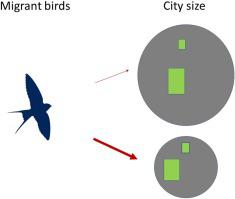当前位置:
X-MOL 学术
›
Urban Forestry Urban Green.
›
论文详情
Our official English website, www.x-mol.net, welcomes your feedback! (Note: you will need to create a separate account there.)
Big cities with small green areas hold a lower proportion of migrant birds: A global analysis
Urban Forestry & Urban Greening ( IF 6.4 ) Pub Date : 2021-01-01 , DOI: 10.1016/j.ufug.2020.126953 Lucas M. Leveau
Urban Forestry & Urban Greening ( IF 6.4 ) Pub Date : 2021-01-01 , DOI: 10.1016/j.ufug.2020.126953 Lucas M. Leveau

|
Abstract Several studies around the world have shown that species richness and proportion of migrant species in bird communities increase toward the poles as a result of increased climatic seasonality and a considerable annual variation of resources. Since migrant species can use urban green areas (UGAs), they may be negatively affected by the loss of green areas and human disturbances. The aim of this study was to analyze the global pattern of migrant species richness and proportion in UGAs, considering the effects of both climatic seasonality and urbanization. Data of bird communities in UGAs were gathered through a search of scientific articles, book chapters, thesis works and unpublished data. Datasets that included a list of observed species, the numbers of parks surveyed and other methodological characteristics were considered for the analysis. Then, generalized linear models were used to relate total bird species richness and migratory species richness and proportion in each dataset to environmental and methodological variables that controlled for different sampling efforts among studies. A total of 37 cities from four continents were analyzed. Total bird richness increased with the size of UGAs and in the northern hemisphere. As expected, richness and proportion of migrants increased with increasing annual range of temperature and precipitation, and was higher in the Northern Hemisphere. Richness and proportion of migrants decreased with increasing population size of cities but increased with size of UGAs surveyed. The results suggest that big cities have a negative impact on richness and proportion of migrant species. However, increasing the size and number of UGAs may benefit migrant species presence in cities.
中文翻译:

拥有小绿地的大城市拥有较低的候鸟比例:全球分析
摘要 世界范围内的多项研究表明,由于气候季节性增加和资源的年度变化相当大,鸟类群落中的物种丰富度和迁徙物种的比例向极地增加。由于迁徙物种可以使用城市绿地(UGA),它们可能会受到绿地减少和人为干扰的负面影响。本研究的目的是分析 UGA 中迁徙物种丰富度和比例的全球格局,同时考虑到气候季节性和城市化的影响。通过搜索科学文章、书籍章节、论文和未发表的数据,收集了 UGA 中鸟类群落的数据。包含观察物种列表的数据集,分析时考虑了调查的公园数量和其他方法学特征。然后,使用广义线性模型将每个数据集中的鸟类总物种丰富度和迁徙物种丰富度和比例与控制研究之间不同采样工作的环境和方法变量相关联。共分析了来自四大洲的 37 个城市。总鸟类丰富度随着 UGA 的大小和北半球的增加而增加。正如预期的那样,随着年温差和降水量的增加,移民的丰富度和比例增加,北半球更高。流动人口的富裕程度和比例随着城市人口规模的增加而下降,但随着接受调查的 UGA 规模而增加。结果表明,大城市对迁徙物种的丰富度和比例有负面影响。然而,增加 UGA 的规模和数量可能有利于城市中迁徙物种的存在。
更新日期:2021-01-01
中文翻译:

拥有小绿地的大城市拥有较低的候鸟比例:全球分析
摘要 世界范围内的多项研究表明,由于气候季节性增加和资源的年度变化相当大,鸟类群落中的物种丰富度和迁徙物种的比例向极地增加。由于迁徙物种可以使用城市绿地(UGA),它们可能会受到绿地减少和人为干扰的负面影响。本研究的目的是分析 UGA 中迁徙物种丰富度和比例的全球格局,同时考虑到气候季节性和城市化的影响。通过搜索科学文章、书籍章节、论文和未发表的数据,收集了 UGA 中鸟类群落的数据。包含观察物种列表的数据集,分析时考虑了调查的公园数量和其他方法学特征。然后,使用广义线性模型将每个数据集中的鸟类总物种丰富度和迁徙物种丰富度和比例与控制研究之间不同采样工作的环境和方法变量相关联。共分析了来自四大洲的 37 个城市。总鸟类丰富度随着 UGA 的大小和北半球的增加而增加。正如预期的那样,随着年温差和降水量的增加,移民的丰富度和比例增加,北半球更高。流动人口的富裕程度和比例随着城市人口规模的增加而下降,但随着接受调查的 UGA 规模而增加。结果表明,大城市对迁徙物种的丰富度和比例有负面影响。然而,增加 UGA 的规模和数量可能有利于城市中迁徙物种的存在。



























 京公网安备 11010802027423号
京公网安备 11010802027423号